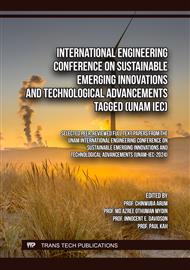[1]
Chinweabu, O.O and Busari, A.O. Flood frequency analysis of River Niger at Lokoja Gauge Station: A morphodynamic approach. Presented at the 1st Faculty of Engineering and Technology International Conference (FETICON, 2023). NLNG Building, University of Ilorin, Nigeria. 5th – 7th June, 2023.
Google Scholar
[2]
Wallis, E., Mac Nally, R. & Lake, P. S. A Bayesian analysis of physical habitat changes at tributary confluences in cobble-bed upland streams of the Acheron River basin, Australia. Water Resources Research, 44, (2008)10.
DOI: 10.1029/2008wr006831
Google Scholar
[3]
Jerie, K., I., H. & Peters, D. Tasmania's river geomorphology: stream character and regional analysis Hobart, Nature Conservation Branch, Dept. of Primary Industries, (2003) Water and Environment.
Google Scholar
[4]
Li, L., Ni, J.R., Chang, F et al, (2020). Global trends in water and sediment fluxes of the world's larger rivers. Science Bulletin, (2020), 65 (1) 62-69.
Google Scholar
[5]
Ferguson, R. Hydraulic and sedimentary controls of channel pattern. River channels, (1987) 129-158.
Google Scholar
[6]
Anderson, R. J., Bledsoe, B. P. & Hession, W. C. Width of streams and rivers in response to vegetation, bank material, and other factors. Journal of the American Water Resources Association, 40, (2004) 1159-1172.
DOI: 10.1111/j.1752-1688.2004.tb01576.x
Google Scholar
[7]
Tan G.M., Fang, H.W., Dey, S. Rui-Jin Zhang's Research on Sediment Transport. Journal of Hydraulic Engineering. 144 (6) 2018.
Google Scholar
[8]
Renschler, C. S., Doyle, M. W. & Thoms, M. Geomorphology and ecosystems: Challenges and keys for success in bridging disciplines. Geomorphology, 89, (2007) 1-8.
DOI: 10.1016/j.geomorph.2006.07.011
Google Scholar
[9]
Arthington, A. H., Naiman, R. J., Mcclain, M. E. & Nilsson, C. Preserving the biodiversity and ecological services of rivers: new challenges and research opportunities. Freshwater Biology, 55, (2010) 1-16.
DOI: 10.1111/j.1365-2427.2009.02340.x
Google Scholar
[10]
Brierley, G. J. & Fryirs, K. A. Geomorphology and River Mangement: applications of the river styles framework, Malden MA, (2005) Blackwell Publishing.
DOI: 10.1002/9780470751367
Google Scholar
[11]
Brooks, A. P., Brierley, G. J. & Millar, R. G. The long-term control of vegetation and woody debris on channel and flood-plain evolution: insights from a paired catchment study in southeastern Australia. Geomorphology, 51, (2003)7-29.
DOI: 10.1016/s0169-555x(02)00323-9
Google Scholar
[12]
Crosato, A. & Mosselman, E. Simple physics-based predictor for the number of river bars and the transition between meandering and braiding. Water Resour. Res., 45 (2009).
DOI: 10.1029/2008wr007242
Google Scholar
[13]
Gurnell, A., Surian, N. & Zanoni, L. Multi-thread river channels: A perspective on changing European alpine river systems. Aquatic Sciences - Research across Boundaries (2009).
DOI: 10.1007/s00027-009-9186-2
Google Scholar
[14]
Simon, A., Doyle, M., Kondolf, M., Shields, F. D., Rhoads, B. & Mcphillips, M. Critical evaluation of how the Rosgen classification and associated "natural channel design" methods fail to integrate and quantify fluvial processes and channel response. Journal of the American Water Resources Association, 43, (2007)1117-1131.
DOI: 10.1111/j.1752-1688.2007.00091.x
Google Scholar
[15]
Blanka, V. & Kiss, T. Effect of riparian vegetation on Floodplain development: case study on River Maros (biogeomorphology). Tajokologiai Lapok, 4, (2006) 301-308.
Google Scholar
[16]
Thomson, J. R., Taylor, M. P. & Brierley, G. J. Are River Styles ecologically meaningful? A test of the ecological significance of a geomorphic river characterization scheme. Aquatic Conservation-Marine and Freshwater Ecosystems, 14, (2004) 25-48.
DOI: 10.1002/aqc.585
Google Scholar
[17]
Bornette, G., Tabacchi, E., Hupp, C., Puijalon, S. & Rostan, J. C. A model of plant strategies in fluvial hydrosystems. Freshwater Biology, 53, (2008) 1692-1705.
DOI: 10.1111/j.1365-2427.2008.01994.x
Google Scholar
[18]
Clark, J. S., Rizzo, d. M., Watzin, M. C. & Hession, W. C. Spatial distribution and geomorphic condition of fish habitat in streams: An analysis using hydraulic modelling and geostatistics. River Research and Applications, 24, (2008) 885-899.
DOI: 10.1002/rra.1085
Google Scholar
[19]
Brierley, G. J. & Fryirs, K. River styles, a geomorphic approach to catchment characterization: Implications for river rehabilitation in Bega catchment, New South Wales, Australia. Environmental Management, 25, (2000) 661-679.
DOI: 10.1007/s002670010052
Google Scholar
[20]
Naito, K., Ma, H., Nittrouer, J., Zhang, Y., Wu, B., Wang, Y., and Fu, X,. Extended Euglund and Hansen type sediment transport relation for mixture based on sand-silt-bed Yellow River, China. Journal of Hydraulic Research Vol 57, No.6 (2019)770-785.
DOI: 10.1080/00221686.2018.1555554
Google Scholar
[21]
Yifei, C., Junqiang, X., Meirong, Z., & Shanshan, D. Improved formula of sediment transport capacity and its application in the lower Yellow River. Journal of Hydrology 631 (2024) 1-12.
DOI: 10.1016/j.jhydrol.2024.130812
Google Scholar


